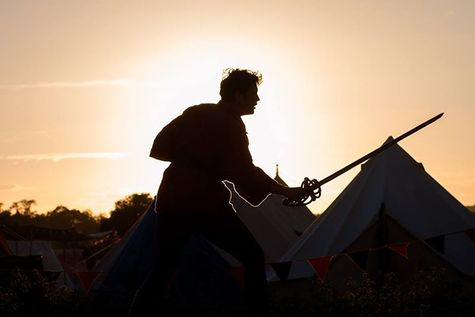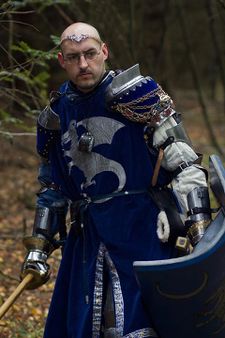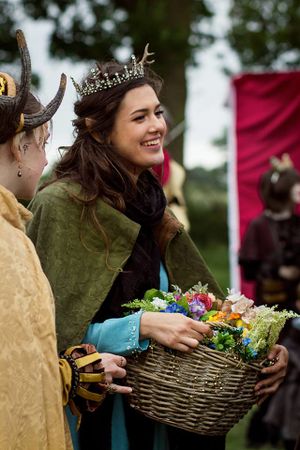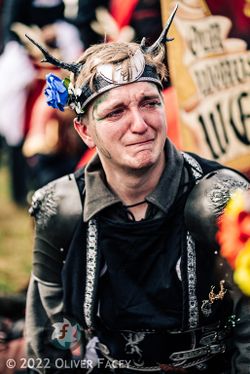Dawn culture and customs
The Test of Mettle
The Imperial citizenship tests were created by the Dawnish but the Test of Mettle remains unique to Dawn. The Test exists to judge who is glorious enough to join the ranks of the nobility. Passing a noble house's test makes the applicant part of that house. Consequently it is almost impossible to pass the test unless the noble house that is judging you is amenable to your success. Dawnish legends are full of tales of heroic individuals passing the tests against such odds, but the reality is usually more prosaic.
Any Imperial citizen is eligible to attempt the Test of Mettle and most scions of noble houses attempt it. In theory any yeofolk child can take the test, a fact of which the Dawnish are inordinately proud. In practice, while the rewards for success are high, the tests are difficult to pass without the support that an upbringing in a noble house provides. The tests are difficult even for noble children and groups of them will often work together to help each other pass their test. Setting an appropriate test is a key part of the responsibilities of the earl of any noble house.
Ignominy befalls those who attempt the test and fail, whether yeofolk or noble born, and the test is difficult to pass and often dangerous, not least because many Dawnish children take the view that you should pass the test or die trying. For this reason most tests are deliberately open-ended, giving the aspirant as much time as is needed to prove their worth. Those attempting to pass their Test of Mettle are formally called knights-errant and are often accorded some of the privileges of nobility.

The Test of Resolve
When a dispute arises between members of a noble house, it falls to the earl to settle the matter. Usually the earl sets a challenge to resolve the matter - a Test of Resolve. Choosing one side or the other risks favouritism. It is much more in the Dawnish spirit for the matter to be settled with a challenge. The loser faces the judgement of the earl, which can be anything up to expulsion from the house. The penalty is announced before the test begins, which has led to several tragic incidents. Refusing to comply with or enforce an agreed penalty causes a great loss of renown for all involved.
A fair test is one that plays equally to both parties' strengths; if two knights are arguing then an earl might order a bout of arms to settle their dispute. If a knight and a troubadour disagree, an earl is much more likely to set them a challenge that does not favour either of their particular skills. It is possible for either party to employ a champion from their house to compete in their stead. Champions are rare however for they share the fate of the noble whose cause they championed if they lose.
Tests of Resolve are often offered to citizens of other nations who bring complaints against individual nobles. They are not always accepted; however, facing such a challenge is a simple way for a foreigner to impress, especially if they can win, or at least lose graciously.
A Test of Resolve between members of a noble house is the only way for a noble to be ejected from the house. Such tests are rare for the challenger risks the same fate as the person they challenge; the loser is stripped of their nobility and reduced to the status of yeofolk. Such a fate is almost irreversible; it is exceptionally rare for another house to allow a former noble to join. They must take a second Test of Mettle to prove themselves and such tests are fatally difficult; it must be clear to everyone who witnesses the test that it was difficult enough to erase the stain of previous failure.

The Test of Ardour
Marriage brings yet another challenge for the Dawnish nobility. The suitor must put their troth to the house of their intended. The earl of the house must set the suitor a test of their choosing, called a Test of Ardour. A request for marriage, like a request for a Test of Mettle, may not be refused. If the suitor succeeds then they marry their intended and become a member of their spouse's house.
In theory such a troth can be put to a house without the understanding of the one the suitor seeks to wed. In practice such behaviour is more the stuff of legend than reality. A Test of Ardour that appears fatally difficult is a sure sign of an unwanted affection. More commonly noble lovers conspire to decide whose earl can be persuaded to set the easier test.
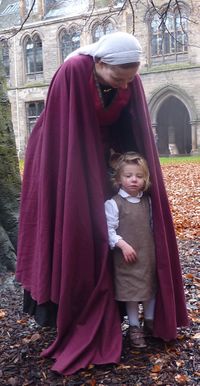
members of the noble house that adopts them
The Test of Ardour is just one of the many complex social rules surrounding marriage in Dawn.
Fostering and adoption
Before Imperial rule forbade war between the houses, it was commonplace for a defeated noble to swear oaths of fealty or good intention. To ensure these oaths were kept, all the noble's children would be taken as hostages. To avoid this fate, a noble would send every second child to be raised in the houses of friends and allies. Over time it became increasingly common for powerful nobles to adopt talented children into their own family.
This custom continued after the Empire brought peace to Dawn, so that now, children passed over at birth are raised as full members of the noble house that adopts them. Such children have the same rights and responsibilities as their siblings who are born into the house; the Dawnish ideal is that an earl should treat all the members of their house as if they were of the same blood. Tawdry tales of earls who fall short of this ideal are common, but it is not unusual for an adopted noble to become earl of a house.
It is possible, though rare, for yeofolk children to be adopted by a noble family. Occasionally it occurs because a child catches the eye of a noble, impressing them with their potential, but usually this is done as an act of gratitude towards a parent by a powerful noble. A common tale in Dawn concerns a noble whose loyal retainer does them a great service, and the noble rewards them by adopting their child - after all, there is little advantage in adoption of an aged retainer to either party.
Heraldry
Every noble house has its own unique heraldry. On the field, in camp, and decorating every castle and manor house in Dawn, is their distinctive heraldry, woven and embellished by the witches of the weaver cabals. Any noble of the house is entitled to bear its arms on their surcote and shield, and when the house marches to war they do so under their banner. Yeofolk require a noble house's permission to bear their arms, but most nobles prefer their retainers to be dressed in their colours, the better to emphasise the glory and majesty of their house.
Although knights-errant are not technically noble, they are permitted to carry the majestic royal blue national banner, displaying a blazing golden sun, and to display the device on their arms. For this reason, nobles who wish to conceal their identity, or house affiliations, sometimes choose to present themselves using Dawn's heraldry rather than their own.
Dawnish heraldry favours bold colours, high contrast stripes and chevrons, and fantastical beasts as devices. Very complex heraldry with multiple divisions and colours is generally avoided as confusing and less splendid than a simpler but more striking design.
On the rare occasions when a noble is exiled from their house, they are usually publicly stripped of their heraldry, their shield defaced, and their name struck from the house's records. In some houses, they are given a cloak or surcote in dull brown undyed cloth as a mark of shame before they are driven out.
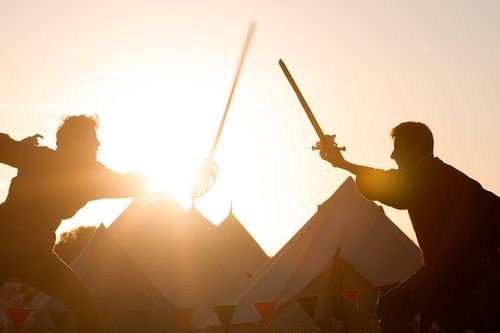
The Grand Tourneys
At each summit, the assembled people of Dawn host a grand tourney, which all Dawnish nobility are eligible to participate in. While yeofolk may not compete, by long tradition of the grand tourney, a blind eye is turned to the participation of knights-errant - who often take part incognito dressed as black knights. The tourney takes the form of a grand melee, the winner being the last participant standing when all others are defeated or have yielded. With help from the troubadours, the champion will be crowned as that season's knight-protector.
The winner could be a witch as easily as a warrior; the contest is open to both. The use of magic is expected in the tourney, and the victor is generally understood to be experienced at dealing with magic in battle regardless of whether they wield magic directly themselves. Regardless of their skills, the knight-protector is expected to help Dawn deal with the realm in question and in particular to be first to stand against any threat that might issue forth from the realm.
Each Knight-Protector is an Imperial title. The winner holds the title for a year, so the Knight-Protector of Winter will reign until the start of the next winter tourney, the Knight-Protector of Spring will reign until next spring - and so on. A reigning knight may not compete in a grand tourney until a year has passed - they can try to retain their title the following year, but they cannot compete for a different title before then, even if they resign their title or are revoked. They are often asked by the egregores to help oversee the other three grand tourneys, as they are not allowed to participate. Only one grand tourney is held each season. If a knight-protector dies, steps down, or is revoked, the title remains vacant until the next time the grand tourney would be held.
To mark the prize, the Dawnish egregores have asked the weavers of Weirwater to recreate a set of glorious banners, one for each of the seasons. The banner will be presented to the winner after the tourney, either by the egregore or by the previous winner. The bearer is expected to protect the banner with their life - and to hang it prominently in their tent at Anvil and in their hall at home where all may see their glory. Each banner bears an enchantment that allows the bearer to pass through any portal connected with a regio - including the ability to visit the Hall of the Worlds. In addition, the knight-protector is treated by the eternals of the appropriate realm as an emissary, and granted certain protections from treachery or violence when treating with them if they carry the banner.
The Night of Flowers
At the Spring Equinox the people of Dawn celebrate their Night of Flowers. Although similar in some respect to the Urizen Festival of Flowers that takes place at the same time, this is a celebration of emotion and openness - although not necessarily of Virtue. Participants are encouraged to "wear their hearts on their sleeves", and it is customarily a time where romantic relationships begin or are renewed. The festival is an important part of Dawnish culture, as it encourages a period of relatively consequence-free communication between the noble houses of Dawn.
During the festivities, the Dawnish mark gifts of flowers to those toward whom they have strong feelings. While it is common to celebrate romantic feelings, flowers may also be given to make feelings of respect, hatred, filial affection, or any number of other emotional ties. As befits a time of new beginnings, the Night of Flowers often sees the formation of new bonds of love, friendship, and respect, or the beginning of fresh rivalries between those who compete for glory.
Every house has their own codes of what flowers mean. Although some flowers have universally accepted meanings, part of the festivities revolve around deciphering the meaning of any flowers that have been received.
As part of the celebration, one member of the nation is chosen to be the Knight of Flowers; a guised figure who can be prevailed upon to carry favours and flowers on behalf of any noble or yeofolk to their intended recipient. The Knight of Flowers is important to the celebration as it is their role to ensure flowers are shared and to help decipher meanings while ensuring that the festivities match the Dawnish spirit. It is seen as an honour to be girded as the Knight of Flowers and (unsurprisingly for Dawn) competition for the right to bear the mantle can be intense.
Those who choose not to partake in the ceremony are encouraged to wear a black sash to display their choice and it is not appropriate to give flowers to these people.
Funerals and births
Funerals are sombre occasions in Dawn, accompanied by a period of public mourning for friends and relatives. A Dawnish funeral often represents a display of grief, an outpouring of passionate despair that a loved one has departed the mortal world. After the funeral itself, the friends and relatives of the departed celebrate the return of the soul to the wheel, and tell great tales of the dead to persuade the hand of destiny to speed the hero’s return, but they do so in the knowledge that the parting of death is something tragic, not something commonplace.
After death, the body is normally interred in a grave, usually marked by flowering plants or trees. Where several people die at once, such as in the aftermath of a battle, a barrow mound may be raised. Graves in Dawn are generally well tended by surviving relatives, and as memory fades they are slowly forgotten. The graves of heroes, however, often become sites of pilgrimage for those inspired by their tales, who also ensure that the site is tended. Several great heroes are interred in the marble tombs of the Necropolis in Highguard, but this is not commonplace. In a nation of glorious heroes, it requires something special for the priests to request that a body be interred in the necropolis to serve as an inspiration to the entire Empire.
There is a tradition of visiting expectant parents and telling tales of great heroes, to awaken the heroism of the unborn baby’s past lives. There is a folk belief that an unborn child has a close connection to the Labyrinth that may persist for up to a year after birth, and if a baby consistently seems to "react" to certain tales, it is taken as a sign that the child may be a reincarnation of one of the characters in that tale. The Imperial Synod does not endorse this belief, but it does not prevent the tradition remaining popular.
Icons and Artistry
The arts of painting, weaving, and tapestry are very popular in Dawn. Dawnish artists favour bold colours and dramatic scenes with the most common subject being either a glorious or romantic figure (or group of figures), or a magical heraldic beast. Art that celebrates the Dawnish virtues is seen as superior to paintings of landscapes or abstract art.
The most easily recognisable Dawnish icon is the golden sun-in-splendour against a blue field. This represents the highest aspirations of the nation and is found everywhere in Dawn. It is especially common as part of the heraldry of a knight-errant. Heraldry is most commonly found on surcotes and banners, but it is often added to shields and favours. In Dawnish eyes, almost anything can be enriched by adding personal or house heraldry to it.
In particular, there is stiff competition to have the finest heraldry and the brightest banners. Weaving is highly-respected talent in Dawn where a resplendently painted, embroidered, or appliquéd banner is a source of immense pride to the artist that creates it, and to the house or noble that bears it aloft. The most coveted Dawnish standards are beautiful and valuable works of art, prized as heirlooms by the house that owns them.
Further Reading
Core Brief
Additional Information
